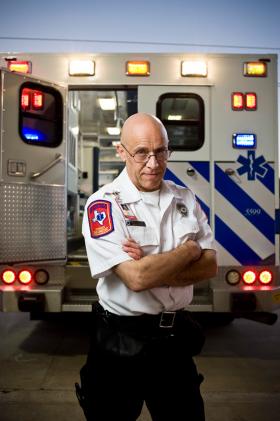 It seems that the answer to that question is much harder to answer than you might think. For most other public safety uniformed professionals, like police officers, sheriffs, and firefighters, although the particular colors might change slightly from department to department, the overall appearance of the actual uniform itself is very similar across many of the branches of the same profession. And this uniformity in what these separate departments choose to outfit their staff with creates a recognizable standard for their uniform across the country that most public citizen’s know without even thinking about it. For the most part if you see a man or women dress in dark blue paramilitary type garb with a badge and a duty belt, you know you are looking at an officer of the law and that they should command a certain level of respect. But what is this easily recognizable standard of uniform for the everyday EMS professional? Other than the fact that they jumped out of an ambulance when you saw them, would you quickly recognize an EMT or paramedic at the scene of an accident?
It seems that the answer to that question is much harder to answer than you might think. For most other public safety uniformed professionals, like police officers, sheriffs, and firefighters, although the particular colors might change slightly from department to department, the overall appearance of the actual uniform itself is very similar across many of the branches of the same profession. And this uniformity in what these separate departments choose to outfit their staff with creates a recognizable standard for their uniform across the country that most public citizen’s know without even thinking about it. For the most part if you see a man or women dress in dark blue paramilitary type garb with a badge and a duty belt, you know you are looking at an officer of the law and that they should command a certain level of respect. But what is this easily recognizable standard of uniform for the everyday EMS professional? Other than the fact that they jumped out of an ambulance when you saw them, would you quickly recognize an EMT or paramedic at the scene of an accident?
Well, it turns out that there is somewhat of a mix of different uniforms that ems professionals where throughout different states and different companies. For some emts and paramedics, their uniform is very much like that of their law enforcement counterparts. A lot of ems workers wear Class A or Class B type uniform shirts with button down fronts, 2 chest pockets, pressed collars, shoulder epaulets, and military creases to present a very professional look. Dark blue, often also associated with police officers, is a very common color among ems and fire ems professionals. Although, there are a lot of departments that choose to where white shirts and match these with black or the dark blue pants. With this Class A/B type look, many units also where metal badges and nametags identifying who they are. They might also where ems patches to help signify their position.
The pants most ems workers wear is often the best place to identify their profession because EMT pants are pretty unique. The key is all the pockets. Not only do they have the regular front and back pockets, they also have lots of pockets on the legs and not just regular cargo pockets. There are special pockets for lots of specialized ems gear like gloves and stethoscopes, etc.
Well, it seems like this is the standard then, right? Not so fast. Beyond this Class A/B type look, there is a much different look that is just as much found in today’s departments. Instead of the button down Class A shirt, they often go a much more casual look with a professional looking polo shirt. This shirt can still be identified through embroidered ems logos or lettering, although slightly less identifiable as the badge and patches. Even less dressy as the polo shirt, some units actually choose to wear solid colored T-Shirts with big EMS, PARAMEDIC, or EMT lettering silkscreened on the back and an ems badge silkscreened on the front chest. As you might expect, this much more comfortable look doesn’t command nearly as much respect as the earlier very dressy Class A look.
And so this difference in what uniforms are like in the emergency medical services arena obviously shows us is that one, there definitely does not seem to be a standardized uniform, but also that there seems to be a bit of a debate about what an ems professional should even be wearing. Either to differentiate themselves from other public safety professionals or to be the right type of clothing for their particular job conditions, it seems that the EMT uniform should have some standard, but no one, in the US at least, can seem to agree on what that uniform should be.
In the next article in this series, we will focus on what kinds of uniforms some ems professionals think might be the best solution for a more standardized EMT uniform.


